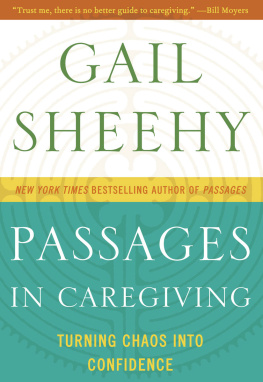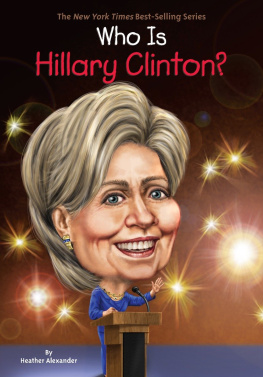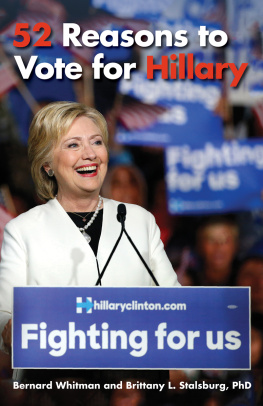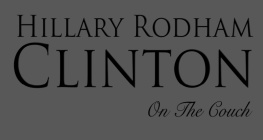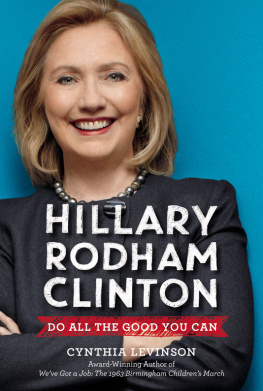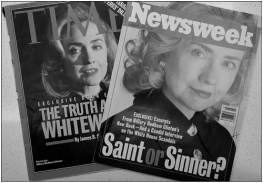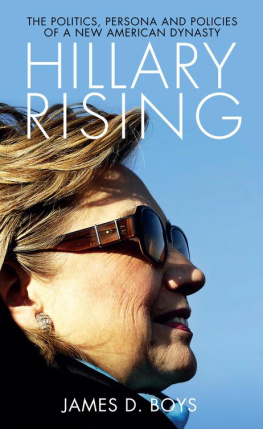
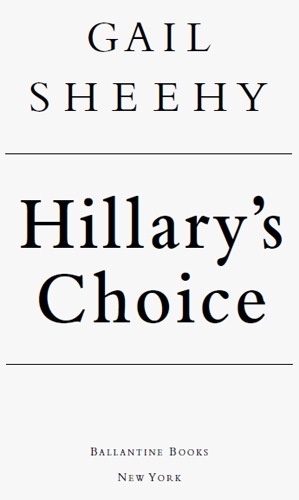
CONTENTS
For Clay
Every one of us has a choice.... I think that in everyday ways, how you treat your own disappointments and whether youre able to forgive the pain that others cause you and, frankly, to acknowledge the pain you cause to others, its one of the big challenges we face as we move into this next century. And its something that I certainly have faced. But I look into the eyes of people all over my country and the world, and I know its something all of us face.1
H I L L A R Y R O D H A M C L I N T O N, 1999
A C K N O W L E D G M E N T S
To write a biography of a subject very much alive and running her own race is rather like a marathon. I did, however, have a seven-year head start, having accompanied Hillary Rodham Clinton in 1992 on her first presidential campaign. From our first encounter I was conscious that here was an extraordinary person, unique on the political stage, and I found myself fascinated enough over the years to follow her public life and personal passages and note my impressions and my conversations with her. Even more intriguing was what she didnt say. The challenge in writing a biographical portrait was to delve behind the masks of a public woman notoriously obsessive about guarding her own privacy and that of those close to her. Hundreds of people possessed pieces of the puzzle. As those people were found and interviewed, in thousands of hours of taped discussions, the thrill was to discover the unknown Hillary Rodham who existed before Bill, and the interlocking between Hillary and Bill Clinton over the course of their turbulent history.
In this marathon I have been coached and supported by two great institutions. Vanity Fair, my journalistic home since 1984, gave me the opportunity for extensive travel and research and published at unusual length two of my articles on Hillary Clinton. Random House, my publisher, paced me as I began, in January 1999, to do the deeper research and the revisiting of origins of character required by a book.
I was lucky to be able to assemble a fine research team, all of whom remained dedicated through many nights and weekends, computer crashes, and the tedium of fact-checking. Led by Bruce Littlefield, my editorial assistant, who gave so much of himself, they were Jason Haber, fact checker; Jan Cottingham in Little Rock; DeDe Lahman; Ann Wozencraft and Heather Kalish in New York; Heather Baukney and Joseph Werzinski in California. My Vanity Fair colleagues Elise OShaunnessey and George Hodgman offered valuable editorial comment, and my computer guru, Josh Skaller, always came to the rescue.
Of all those who provided original material, I would particularly like to thank Dorothy Rodham, Hillarys mother, who was the first to share with me her insights and favorite photographs. I was fortunate to locate Professor John Peavoy, a high school classmate of Hillarys, who showed me the thirty letters that Hillary had written to him during her college years, a period when she was mutating both socially and politically. Don Jones, the Methodist minister who has been an intellectual touchstone for Hillary over the years, was equally generous in helping to place letters from Hillary in the context of various stages of her life. Dr. Arthur Curtis was a resourceful guide to the subculture of Park Ridge. David Rupert, Nancy Pietrefesa, and John Danner were helpful in filling in the postgraduate period. For their assistance in tracking the Arkansas years, I am grateful to Mary Lee and Paul Fray, Claudia Riley, Susan McDougal, Carolyn Yeldell Staley, Bobby Roberts, and Joe Purvis. Fellow journalists in Little RockGene Lyons, Max Brantley, and John Brummettoffered not only facts, but a healthy dose of skepticism and hearty laughs. Thanks, too, to Judy Lange, librarian at Main South High School.
I am indebted to Betsey Wright for her trust and candor. The Reverend Ed Matthews was a revelation. Dick Morris provided a through-line of real politik from his seventeen years of experience as a Clinton strategist, together with his wife, Eileen McGann. Dee Dee Myers, now a colleague at Vanity Fair, was extremely helpful, as were former White House attorneys Bernard Nussbaum and Jane Sherburne. Melanne Verveer, Dr. Susan Blumenthal, Ann Lewis and Mandy Grunwald cooperated to the degree they could without incurring the First Ladys wrath. I would also like to thank Don Baer, Robert Boorstin, Bill Curry, Lanny Davis, Rose Styron, Senator Chistopher Dodd, Senator Joseph Lieberman, Congresswoman Nita Lowey, Congressman Charlie Rangel, and Judith Hope.
Words are inadequate to express my esteem for my editor, Robert Loomis, who was always there as a touchstone of clarity and paragon of patience throughout the extended marathon. Many members of the Random House family, including editor in chief Ann Godoff, legal adviser Lesley Oelsner, art director Robbin Schiff, interior designer Barbara Bachman, picture researcher Sarah Longacre, production editor Sybil Pincus, copy editor Lynn Anderson, editorial assistant Barb Hammer, and production manager Richard Elman spared no effort even as they sprinted the book into print. My agent, Lynn Nesbit, was as always an enthusiastic champion.
My heartfelt thanks to Ella Council for sustaining us all and, finally, to my husband and resident editor, Clay Felker, for his gift of constant belief and surrender of so much of my attention.
C H A P T E R O N E
Into the Flames
These two people are intertwined on every level,
as a man and woman, as friends, as lovers,
as parents, as politicians. This is a love story.
LINDA BLOODWORTH-THOMASON
When under siege she rises early, dresses quickly, and cauterizes her emotions. The bubble of anger rising from her gut will remain level. Head must be separated from heart. Of necessity, given her station in life, she will summon her apolitical Washington hairstylist, Isabel, to blow, wax and spray her expensively blonded hair into an unflappable helmet. She does not read the newspapers. Or watch TV. She does not want to know any more about her husbands scandalous behavior than she absolutely has to know.
This morning, Tuesday, January 27, 1998, scarcely a week into the firestorm of accusations about a President and a dark-haired intern in an unforgettable beret, she does not worry about makeup. The Today shows makeup artists are able to make a tense First Lady look serene (or, a year later, a vampy intern look like a proper author). It is five in the morning and Hillary Rodham Clinton paces around her suite in the Waldorf-Astoria, priming herself for yet another crucial television appearance that will either pull Bill Clinton out of a nosedive or help ensure a crack-up. Dark smudges beneath her eyes belie her apparent equipoise. She joins her chief of staff, Melanne Verveer, and rides stoically across Fifth Avenue, arriving at NBCs Rockefeller Center studio. Anchor Matt Lauer, who was called back from vacation when the story broke, has the outlines of a scandal that already sounds like the finale of the Clinton Show.
At 6:55 A.M., between promos and airtime, Lauer dashes up to the makeup room to greet the First Lady. She is warm, though some tension is detectable in her demeanor. Thats hardly surprising. In the six days since the sex-and-lies scandal broke, the face of Monica Lewinsky and a few squirmy denials by the President have occupied the first half hour of all the morning TV shows and carpeted the cable shows wall to wall. Is there anyone in America who has not heard accusations that the President enjoyed sex sessions in the White House with an intern barely older than his daughter and then told her to lie about it?
Next page

